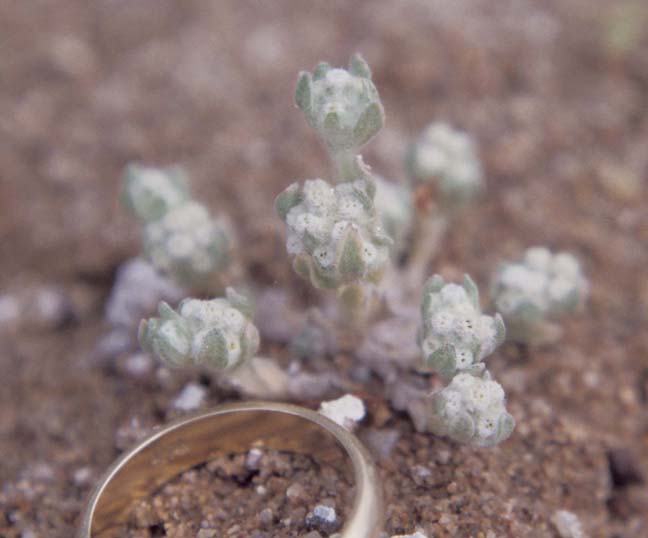
|
Family: Asteraceae |
Annuals, 3-25 cm. Stems 1, erect, or 2-10, ascending to ± prostrate. Leaves basal and cauline; alternate; blades oblanceolate to obovate. Heads borne singly or in glomerules of 2-40+ in ± dichasiform, pseudo-polytomous, spiciform, or racemiform arrays. Involucres inconspicuous. Phyllaries (2-)4-6, ± equal (similar to paleae). Receptacles pulvinate to conic (heights 0.2-2.4 times diams.), glabrous. Pistillate paleae readily falling (all or inner together, ± coherent distally by tangled indument) or outermost sometimes persistent, erect to ascending; bodies with 5+ nerves (nerves ± parallel, obscure), oblanceolate to oblong, flat to concave most of lengths (not enclosing florets); wings 0. Staminate or bisexual paleae readily falling (coherent with pistillate), (1-)3-5, erect to apically somewhat spreading or incurved (scarcely enlarged) in fruit, slightly surpassing pistillate paleae; bodies ± spatulate (apices entire, sometimes involute and ± gibbous). Pistillate florets 13-35+. Functionally staminate or bisexual florets 2-5; corolla lobes mostly 4, equal or unequal. Cypselae light to dark brown, monomorphic: terete to obcompressed, ± obovoid, ± straight, not gibbous, faces glabrous, minutely papillate, dull or ± shiny; corolla scars apical; pappi 0. x = 7. See discussion of Filagininae following the tribal description (p. 385). Diaperia occurs in open, moist or dry habitats of humid to semiarid, temperate to subtropical climates. Though apparently not aggressively invasive in their native range, the species are competitive in disturbed habitats (vacant lots, fallow fields, lawns, cemeteries, and roadsides). Diaperia verna var. verna, in particular, is widely regarded as a weed; the species are potentially invasive outside the flora. Diaperia appears to be monophyletic, with ancestors near Evax sect. Filaginoides Smoljaninova of the Mediterranean basin and central Asia (particularly E. eriosphaera Boissier & Heldreich; J. D. Morefield 1992). It is separated from Evax by stems well-developed, leafy, usually branched, paleae falling together (coherent distally by tangled indument), and staminate paleae somewhat enlarged, apices obtuse, ± herbaceous, uniformly hairy (Morefield 2004). Species of Diaperia are sharply distinct by size, shape, and arrangement of branches, glomerules, heads, and capitular leaves. Diaperia candida is aberrant by its inner florets bisexual, bisexual paleae distally gibbous, and reported chromosome complement of 2n = 14 (D. J. Keil and D. J. Pinkava 1976). These traits might eventually justify resurrection of the monotypic Calymmandra Torrey & A. Gray, after further study and confirmation of the chromosome number. While 2n = 14 is common elsewhere in Gnaphalieae, all other 25 counted species of Filagininae have 2n = 28 (species of Evax, Filago, Logfia, Micropus, Psilocarphus, and Stylocline) or 2n = 26 (Diaperia and Evax). The implication that D. candida retains an ancestral diploid condition has no phylogenetic support (J. D. Morefield 1992).
|



